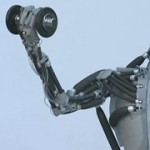Результат поиска - найдено feed199
That which does not stabilize, will only make us stronger
- Тип контента: Научная статья
- Номер документа: 1558
- Название документа: That which does not stabilize, will only make us stronger
- Номер (DOI, IBSN, Патент): 10.1109/ICORR.2007.4428369
- Изобретатель/автор: Kazerooni, H.
- Правопреемник/учебное заведение: Professor, University of California-Berkeley, USA
- Дата публикации документа: 2008-01-14
- Страна опубликовавшая документ: США
- Язык документа: Английский
- Наименование изделия: Не заполнено
- Источник: http://ieeexplore.ieee.org/search/freesrchabstract.jsp?tp=&a
- Вложения: Да
- Аналитик: Дмитрий Соловьев
 Many places in the world are too rugged or enclosed for vehicles to access. Even today, material transport to such areas is limited to manual labor and beasts of burden. Modern advancements in wearable robotics may make those methods obsolete. Lower extremity exoskeletons seek to supplement the intelligence and sensory systems of a human with the significant strength and endurance of a pair of wearable robotic legs that support a payload. This article first outlines the use of Clinical Gait Analysis data as the framework for the design of such a system at UC Berkeley. This data is used to design the exoskeleton degrees of freedom and size its actuators. It will then give an overview of one of the control schemes implemented on the BLEEX. The control algorithm described here increases the system closed loop sensitivity to its wearer’s forces and torques without any measurement fromthe wearer (such as force, position, or electromyogram signal). The control algorithm uses the inverse dynamics of the exoskeleton, scaled by a number smaller than unity, as a positive feedback controller. This controller almost destabilizes the system since it leads to an overall loop gain slightly smaller than unity and results in a large sensitivity to all wearer’s forces and torques thereby allowing the exoskeleton to shadow its wearer.
Many places in the world are too rugged or enclosed for vehicles to access. Even today, material transport to such areas is limited to manual labor and beasts of burden. Modern advancements in wearable robotics may make those methods obsolete. Lower extremity exoskeletons seek to supplement the intelligence and sensory systems of a human with the significant strength and endurance of a pair of wearable robotic legs that support a payload. This article first outlines the use of Clinical Gait Analysis data as the framework for the design of such a system at UC Berkeley. This data is used to design the exoskeleton degrees of freedom and size its actuators. It will then give an overview of one of the control schemes implemented on the BLEEX. The control algorithm described here increases the system closed loop sensitivity to its wearer’s forces and torques without any measurement fromthe wearer (such as force, position, or electromyogram signal). The control algorithm uses the inverse dynamics of the exoskeleton, scaled by a number smaller than unity, as a positive feedback controller. This controller almost destabilizes the system since it leads to an overall loop gain slightly smaller than unity and results in a large sensitivity to all wearer’s forces and torques thereby allowing the exoskeleton to shadow its wearer.
Категория: Научные статьи | Нет комментариев »
Development of an electro-mechanically controlled hand orthosis for assisting finger extension in stroke survivors
- Тип контента: Научная статья
- Номер документа: 6139
- Название документа: Development of an electro-mechanically controlled hand orthosis for assisting finger extension in stroke survivors
- Номер (DOI, IBSN, Патент): 1909–9762
- Изобретатель/автор: Neil Petroff, Juliana Villa Bedoya
- Правопреемник/учебное заведение: Escuela de Ingeniería de Antioquia–Universidad CES, Medellín, Colombia
- Дата публикации документа: 2007-11-07
- Страна опубликовавшая документ: Колумбия
- Язык документа: Английский
- Наименование изделия: Не заполнено
- Источник: Revista Ingeniería Biomédica
- Вложения: Да
- Аналитик: Глаголева Елена
 Stroke is the leading cause of long-term disability in the world. It causes chronic deficits, such as hemiparesis, especially prevalent in the distal upper extremities. An electro-mechanically driven hand orthosis has been developed to assess the potential thera-peutic use of such devices in rehabilitating hand function. A small Direct Current (DC) brushed motor is used as the main actuator, and a cable-driven glove connected to the motor shaft is the central component of the device. The orthosis control is achieved through a force feedback loop using a miniature load cell attached in series to the cable and control module. The later, generates Pulse Width Modulated (PWM) and direction signals required to drive the motor. The speed is determined by the duty cycle of the PWM signal while the direction by the status of a flag bit modified by a user-operated switch. A portable design was achieved by using a 6 V battery pack as the power supply. The device is ready for use in clinical trials with stroke survivor subjects as it has already been tested on healthy individuals with satisfactory per-formance.
Stroke is the leading cause of long-term disability in the world. It causes chronic deficits, such as hemiparesis, especially prevalent in the distal upper extremities. An electro-mechanically driven hand orthosis has been developed to assess the potential thera-peutic use of such devices in rehabilitating hand function. A small Direct Current (DC) brushed motor is used as the main actuator, and a cable-driven glove connected to the motor shaft is the central component of the device. The orthosis control is achieved through a force feedback loop using a miniature load cell attached in series to the cable and control module. The later, generates Pulse Width Modulated (PWM) and direction signals required to drive the motor. The speed is determined by the duty cycle of the PWM signal while the direction by the status of a flag bit modified by a user-operated switch. A portable design was achieved by using a 6 V battery pack as the power supply. The device is ready for use in clinical trials with stroke survivor subjects as it has already been tested on healthy individuals with satisfactory per-formance.
Категория: Научные статьи | Нет комментариев »
Создатели руки скопировали анатомию человека
- Тип контента: Новостная статья
- Номер документа: 2263
- Название документа: Создатели руки скопировали анатомию человека
- Номер (DOI, IBSN, Патент): Не заполнено
- Изобретатель/автор: Не заполнено
- Правопреемник/учебное заведение: Не заполнено
- Дата публикации документа: 2007-08-29
- Страна опубликовавшая документ: Россия
- Язык документа: Русский
- Наименование изделия: Не заполнено
- Источник: http://www.membrana.ru/particle/3222
- Вложения: Не заполнено
- Аналитик: Ридна Украина)))
 Фантастика стала ещё на один шажок ближе к реальности. Новая рука для робота — это замечательный пример комбинации принципов биомиметики и мехатроники. Увидев её, кто-то непременно вспомнит Терминатора, но изобретение должно найти массу мирных областей применения.
Фантастика стала ещё на один шажок ближе к реальности. Новая рука для робота — это замечательный пример комбинации принципов биомиметики и мехатроники. Увидев её, кто-то непременно вспомнит Терминатора, но изобретение должно найти массу мирных областей применения.
Категория: Двигатели | Нет комментариев »
Electrostatic actuator with fault tolerant electrode structure
- Тип контента: Патент
- Номер документа: 5232
- Название документа: Electrostatic actuator with fault tolerant electrode structure
- Номер (DOI, IBSN, Патент): US007239065B2
- Изобретатель/автор: Horst R.W.
- Правопреемник/учебное заведение: Tibion Corporation, Moffett Field, CA, USA
- Дата публикации документа: 2007-07-03
- Страна опубликовавшая документ: США
- Язык документа: Английский
- Наименование изделия: Не заполнено
- Источник: http://www.google.com/patents/US7239065
- Вложения: Да
- Аналитик: Дмитрий Соловьев
 A high-power electrostatic actuator comprising rotor and stator layers with fault-tolerant electrode structures, a housing to contain the electrodes and dielectric fluid, and electronic circuitry driving a plurality of high-voltage phases. The actuator is constructed from multiple rotor and stator films separated by spacing elements. The electrode structure provides self-alignment for precise assembly. The actuator assembly includes built-in fine-position sensors to allow optimal timing in powering phases, and a coarse position sensor for feedback control. The electrode structure has a large region of linear force to provide low torque-ripple allowing simple high/low voltage pulsing instead of analog high voltage waveforms. Single or double sided flexible circuit manufacturing techniques are used to fabricate the rotor and stator films at low cost.
A high-power electrostatic actuator comprising rotor and stator layers with fault-tolerant electrode structures, a housing to contain the electrodes and dielectric fluid, and electronic circuitry driving a plurality of high-voltage phases. The actuator is constructed from multiple rotor and stator films separated by spacing elements. The electrode structure provides self-alignment for precise assembly. The actuator assembly includes built-in fine-position sensors to allow optimal timing in powering phases, and a coarse position sensor for feedback control. The electrode structure has a large region of linear force to provide low torque-ripple allowing simple high/low voltage pulsing instead of analog high voltage waveforms. Single or double sided flexible circuit manufacturing techniques are used to fabricate the rotor and stator films at low cost.
Категория: Патенты | Нет комментариев »
Mechanical System Design of a Haptic Cobot Exoskeleton
- Тип контента: Научная статья
- Номер документа: 7415
- Название документа: Mechanical System Design of a Haptic Cobot Exoskeleton
- Номер (DOI, IBSN, Патент): Не заполнено
- Изобретатель/автор: Eric B. LaFay
- Правопреемник/учебное заведение: Russ College of Engineering and Technology of Ohio University
- Дата публикации документа: 2007-06-29
- Страна опубликовавшая документ: США
- Язык документа: Английский
- Наименование изделия: Не заполнено
- Источник: Не заполнено
- Вложения: Да
- Аналитик: Глаголева Елена
 This thesis presents a mechanical system design of a haptic cobot exoske-leton for use in physical therapy rehabilitation. The exoskeleton will be the first exoskeleton to offer cobot technology in a wearable haptic device. This exoskeleton provides a significant improvement in existing haptic exoskeleton technology by providing high performance haptic feedback while maximizing the user’s safety. An overall system and subsystem design is presented; which includes a spherical 3RRR mechanism for the shoulder. A detailed design of the shoulder mechanism is presented in five parts: a range of motion study, the kinematic parameters, the kinematics, kinematic optimization and a collision study. The range of motion study is based anatomical data collected using a Flock of Birds motion capture device. The design process for optimization of the shoulder mechanism is presented in which the shoulder mechanism is optimized by examining the Jacobian matrix with the lowest inverse condition number and global condition index. The result is an practical design of a exoskeleton with a high performance shoulder mechanism that is capable of reaching nearly a quarter of workspace developed by the Flock of Birds.
This thesis presents a mechanical system design of a haptic cobot exoske-leton for use in physical therapy rehabilitation. The exoskeleton will be the first exoskeleton to offer cobot technology in a wearable haptic device. This exoskeleton provides a significant improvement in existing haptic exoskeleton technology by providing high performance haptic feedback while maximizing the user’s safety. An overall system and subsystem design is presented; which includes a spherical 3RRR mechanism for the shoulder. A detailed design of the shoulder mechanism is presented in five parts: a range of motion study, the kinematic parameters, the kinematics, kinematic optimization and a collision study. The range of motion study is based anatomical data collected using a Flock of Birds motion capture device. The design process for optimization of the shoulder mechanism is presented in which the shoulder mechanism is optimized by examining the Jacobian matrix with the lowest inverse condition number and global condition index. The result is an practical design of a exoskeleton with a high performance shoulder mechanism that is capable of reaching nearly a quarter of workspace developed by the Flock of Birds.
Категория: Научные статьи | Нет комментариев »
Статистика
Категорий: 179
Статей всего: 2,003
По типу:
Видео: 36
Выдержка с форума: 1
Контактные данные: 12
Научная статья: 1388
Не заполнено: 5
Новостная статья: 317
Обзор технологии: 42
Патент: 219
Тех.подробности: 34
Тип: 1
Комментариев: 8,866
Изображений: 3,005
Подробней...
ТОР 10 аналитиков
-
Глаголева Елена - 591
Дмитрий Соловьев - 459
Helix - 218
Ридна Украина))) - 85
Наталья Черкасова - 81
max-orduan - 29
Елена Токай - 15
Роман Михайлов - 9
Мансур Жигануров - 4
Дуванова Татьяна - 3
Календарь
| Пн | Вт | Ср | Чт | Пт | Сб | Вс |
|---|---|---|---|---|---|---|
| « Ноя | ||||||
| 1 | 2 | |||||
| 3 | 4 | 5 | 6 | 7 | 8 | 9 |
| 10 | 11 | 12 | 13 | 14 | 15 | 16 |
| 17 | 18 | 19 | 20 | 21 | 22 | 23 |
| 24 | 25 | 26 | 27 | 28 | 29 | 30 |
Авторизация
Ошибка в тексте?
Выдели её мышкой!
И нажми Ctrl+Enter